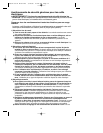
10
• Set the collar to the lowest torque setting.
• Tighten the first screw.
• If the clutch ratchets before the desired result is achieved, increase the collar setting
and continue tightening the screw. Repeat until you reach the correct setting. Use this
setting for the remaining screws.
Switching on and off
• To switch the tool on, press the variable speed switch (1). The tool speed depends on how
far you press the switch.
• For continuous operation, press the lock-on button (2) and release the variable speed
switch. This option is available only at full speed.
• To switch the tool off, release the variable speed switch. To switch the tool off when in
continuous operation, press the variable speed switch once more and release it.
WARNING: The drill should only be locked ON when it is held stationary in a drill press
stand or other means; NOT BY HAND! Never unplug the tool with the locking feature
engaged. To do so will cause the tool to start immediately the next time it is plugged in.
Drilling
• Always move clutch to “DRILL” mode when drilling (DR330 only).
• Always unplug the drill when attaching or removing accessories. When attaching
accessories in the drill chuck, it is important to securely tighten the chuck using all three
holes to prevent slippage. When using a keyless chuck, hand tighten firmly.
• Use sharp drill bits only.
• Support and secure work properly, as instructed in the Safety Instructions.
• Use appropriate and required safety equipment, as instructed in the safety instructions.
• Secure and maintain work area, as instructed in the safety instructions.
• Run the drill very slowly, using light pressure, until the hole is started enough to keep the
drill bit from slipping out of it.
• Apply pressure in a straight line with the bit. Use enough pressure to keep the bit biting
but not so much as to stall the motor or deflect the bit.
• Hold the drill firmly with both hands to control its twisting action.
• Drills (DR550, DR650) equipped with a side handle must be used.
• DO NOT CLICK THE TRIGGER OF A STALLED DRILL OFF AND ON IN AN ATTEMPT
TO START IT. DAMAGE TO THE DRILL CAN RESULT.
• Minimize stalling on breakthrough by reducing pressure and slowly drilling through the
last part of the hole.
• Keep the motor running while pulling the bit out of a drilled hole. This will help reduce
jamming.
• Plug in drill. Make sure switch turns drill on and off.
Drilling In Wood
Holes in wood can be made with the same twist drill bits used for metal or with spade bits.
These bits should be sharp and should be pulled out frequently when drilling to clear chips
from the flutes.
Drilling In Metal
Use a cutting lubricant when drilling metals. The exceptions are cast iron and brass which
should be drilled dry. The cutting lubricants that work best are sulfurized cutting oil or lard
oil.
Drilling in Masonry (Shift drill into hammer mode if so equipped)
Use carbide tipped masonry bits. Refer to
Drilling
section. Keep even force on the drill but
not so much that you crack the brittle material. A smooth, even flow of dust indicates the
proper drilling rate.
638911-00 02 DR drills 3/20/08 10:20 AM Page 10


















